A Comparative Study of Different Models on Image Colorization using Deep Learning
1,2,3,4 Students, Dept. of Electronics & Communication Engineering, R.V.R & J.C College of Engineering, Guntur, Andhra Pradesh, India
5Associate Professor, Dept. of Electronics & Communication Engineering, R.V.R & J.C College of Engineering, Guntur, Andhra Pradesh, India ***

Abstract - Black-and-white image colorization by humans is a difficult and futile task. Photoshop editing has been tried, but it turns out to be delicate because it necessitates extensive research and takes up to a month to colorize an image. The work can be accomplished well by using sophisticated image colorization techniques. The literature on image colorization has drawn attention during the past ten years because it sits at the intersection of two obscure fields, deep learning, and digital image processing. This project aims to influence the advantages of transfer learning byutilizingthe increasingavailabilityofend-to-end deep learning models. Deep learning algorithms like convolutional neural networks can be used to automatically uproot image features from the training data (CNN). Deep neuralnetworks andhumaninvolvementcanbothbeused to achieve this. The performance of these models will be compared as image colorization is enforced in this design utilizing colorful CNN models.
Key words: Deep learning, Colorization, CNNs, pretrained model, Transfer learning.
1. INTRODUCTION
Generally,theideaofcoloringagrayscaleimageisa task that's simple for the natural mind, we learn from an early age to fill in missing colors in coloring books, by flashingbackthatlawnisgreen,theskyisbluewithwhite cloudsorthatanapplecanberedorgreen.
In some disciplines, automatic colorization can be truly useful indeed without the semantic understanding of the image, the simple act of adding color can increase the quantityofinformationthatwegatherfromanimage.For illustration,it'sgenerallyusedinmedicalimagingtoenrich visualqualitywhenviewedbythenaturaleye.Themajority ofkitsusedformedicalimagingcapturesgrayscaleimages, and these images may contain a region that is delicate to interpret, due to the incapability of the eye of an average persontodistinguishotherthansomeshadesofgrayish[1]
As a computer vision task, several user-supported techniques have been proposed for colorization, be it for
natural or hand-drawn images, and anticipate supplied localized color hints, or handed reference images that are semantically analogous to the target image that we can transfercolorfrom,orindeedjustkeywordsdescribingthe image, to search the web for the reference images automatically.
Though, the high-ranking understanding of scene compositionandobjectrelationsneededforthecolorization of further complex images remains the reason developing new,completelyautomatedresultsisproblematic.
Newly, the approach to this task has shifted significantly from user-supported techniques to completely automated results, enforced generally by convolutional neural networks. Research in this area seeks to make automated colorizationcheaperandlowertime-consuming,andbythat, allowingitsoperationonalargerscale.
Withthearrivalofdeepconvolutionalneuralnetworks,the taskhasbeengettingincreasedquantitiesofattentionasa representative issue for complete visual understanding of artificialintelligence,analogoustowhatnumerousallowed object recognition to be preliminary, since to truly convincinglycolorizeatargetimage,thetechniqueneedsto besuitabletorightlyanswerseveralsubtasksanalogousto segmentation,classification,andlocalization.
Ourintentionisn'tnecessarilytorecovertheactualground truenesscolor,butrathertoproduceaprobablecolorization thatcouldpotentiallywisecrackanaturalviewer.Thus,our task becomesmuchfurtherattainabletomodel enough of thestatisticaldependencesbetweenthesemanticsandthe texturesofgrayscaleimagesandtheircolorinterpretations toproducevisuallycompellingresults.
Given the lightness channel L, our system predicts the correspondingaandbcolorchannelsoftheimageintheCIE Lab colorspace. To break this problem, we use large-scale data.Predictingcolorhasthenicepropertythattrainingdata is virtually free any color photograph can be used as a trainingillustration,simplybytakingtheimage’sLchannel asaninputanditsabchannelsastheadministrativesignal. Othershavenotedtheeasyopennessoftrainingdata,and
former workshops have trained convolutional neural networks(CNNs)topredictthecoloroftheimagesonlarge datasets.
Inthispaper,wecomparethethreemodelswhicharebuilt by CNNs. One of the models is baseline CNN, Inceptionresnet-v2, and the last model is based on the Caffe framework.ThefirsttwomodelsarebasedonTensorflow and Keras frameworks. Here we are using pre-trained networks: Inception resnet v2 and the Caffe framework model.
2. RELATED WORKS

Theseveralwaysforaddingchrominancevaluestoa Grayscale image are talked over in this section. Indeed, thoughtherearenumerousways,there'snooptimumresult for this problem. Some of the colorization ways are luminance keying, scribble-grounded colorization, and colorization by meager representation. The problem with thesewaysisthattheydemandconsiderabletroublefromthe user.
2.1 Luminance Keying
The previous colorization technique is called luminancekeying Itwasproposedin1987byR.C.Gonzalez [2].Herecolorizationisachieved byreferringtoa look-up table in which each grayscale level is mapped toa specific hue,saturation,andbrightness.Thelookuptableisdefined bytheuser.Itreducesuserworkbutproduceslow-quality outputs and also it often fails to produce natural-looking coloroutputs.Luminancefluctuationisoneoftheproblems whichiscommonInoldmovies.However,thistechniquewas usedextensivelyinthesetimes.
2.2 Colorization by Scribbling
A scribble-predicated colorization method was introduced by Levin et al[3]. This semi-automatic method requirestheusertomarkcertaincolorscribblesontheinput grayishimage.Automaticpropagationalgorithmspropagate these scribbled colors over the image to produce the final yield. These algorithms are grounded on the idea that neighboring pixels that have analogous intensities can be markedbyanalogouscolors.Poorqualitycolorizedoutputs areproducedwithcolorbleedingeffectsatedgessincethe colorscratchesarenoticeableroughlywithoutconsidering boundaries and edges. Some other methods similar to scribblingwereintroducedbyH.Nodain2006andD.Niein 2007[4][5].However,scribblemarkingremainedaburden inthecaseofnoviceusers.X.Ding,Y.Xu,L.Deng,andX.Yang proposed an automatic scribble-generation technique in 2012 [6] but still the color of each scribble needs to be specified manually This technique was used by graphic artiststocolorizeoldflickswithlimiteduserwork
2.3 Colorization by Sparse Representation
An illustration-based colorization method was introducedbyBoLi,FuchenZhao,ZhuoSu,XiangguoLiang, Yu-KunLai,andPaulL.Rosin[7].Thealgorithmtakesacolor imagecalledareferenceimagealongwiththeinputgrayscale image.Thistechniqueoperatesatthesuperpixelpositionand hence it's an effective way. High, medial, and low position featuresarepulledfromeachsuperpixel,andadescriptoris formed by concatenating them. The feature vectors correspondingtothereferenceimageconstituteawordbook. The intensity values of the corresponding target and reference image superpixels are rooted and compared. polychromaticvaluesaretransferredfromreferencetotarget superpixelwheneveramatchissetup.Eventually,anedgeconservingfilterisdevelopedforchrominancechannelsto conserve edges and boundaries. This system produces comparativelygoodresultsbutthecomputationalcomplexity istoohighandalso,andit'satime-consumingprocesshence operationsarecarriedoutatthesuperpixelpositionusedby graphicartiststocolorizeoldflicksbylimiteduserwork
3. MODELS
3.1 Model 1
The general system channel is talked over in Fig 1[12]. Fig 2 represents the total number of trainable and non-trainableparameters.Thedatasetcollectionisthefirst phasewhichdealswithcollectingapplicabledatademanded for training purposes. Since it's veritably delicate to deal with a general dataset due to the limited memory and hardware specifications, the proposed system dataset is limitedtonaturalfaceimagesinRGBcolorspace.Thetest datasetisusedforassessingtheeffectivenessofourneural network.Severaloperationsareperformedonthetraining datatofindthecharacteristicsthatlinkinputtooutputdata. Thetrainingdatasetissubordinatedtopre-processingand segmentationfirst.Pre-processingiscarriedoffforremoving noisefromtherawdata.Thenscalingandnormalizationare thepre-processingwaysappliedtoachieveuniformityover thedataset.Imagesinthedatasetarescaledtoconfinesof 256X256X3 during this step. The segmentation step deals with partitioning each image into different parts to pull featuresfromit.
Duringthefeatureextractionphase,RGBvaluesarepulled from each pixel by reducing the image size in three ways. The 256X256 image is reduced to 128X128 and lower positionpatternsareuprooted.Togaindetailedpatterns,the sizeisagainreducedtohalfwhichis64X64
More complex and minute details can be uprooted by reducing the size by 32X32. After this step, each pixel intensityvalueisattained.Basedontheuprootedfeatures,a modelisgenerated.
This model may have errors and therefore cannot be finalized as an effective model. To make it accurate and effectivebyavoidingerrors,itpassesthroughthetraining phase. The training includes a backpropagation technique which works in a trial-and-error manner. The errors are reduced and a more effective learned network is attained duringthisphase Ithasmainlythreelayers.Theinputlayer, severalhiddenlayers,andthelastistheoutputlayer. The trainedmodelisgivenawaytoaneuralnetworkclassifierto achieve the colorization of new inputs in the future. The classifieridentifiestheordersofinputsgroundedonthe

Information from the trained data. Logistic regression, Bayesianclassifier,andSVM(SupportVectorMachine)are illustrationsofclassifiers.Afterallthesephases,theneural network can accept new inputs and produce colorized outputimages
3.2 Model 2
This model owes to [8] Given the luminance elementofanimage,themodelestimatesitsa*b*factors andcombinesthemwiththeinputtogainthefinalestimate of the colored image. Rather than training an attribute extraction branch from scratch, we make use of an Inception-ResNetv2networkshowninFig3(appertainedto asInceptionhenceforth)andgetbackanembeddingofthe gray-scale image from its last layer. Here we make use of transferlearningwhichcontainsmainlytwophases.Oneis to extract the features and second is the to fine-tune of modelparametersofthepre-trainedmodel.Thenetworkis logically divided into four main factors. The encoding and the attribute extraction components gain mid and highpositionfeaturesindependentlywhicharealsointermingled in the fusion layer. Eventually, the decoder uses these featurestoestimatetheoutput.
Preprocessing: To assure correct learning, the pixel values of all three image elements are centered and scaledtogainvalueswithintheintervalof(-1,1).
Encoder: The Encoder processes H × W gray-scale images and outputs an H/ 8 × W/ 8 × 512 attribute representation. To this end, it uses 8 convolutional layers with3×3kernels.Paddingisusedtosavethelayer’sinput size.Likewise,thefirst,third,andfifthlayersapplyastride of2,consequentiallyhalvingthedimensionoftheiroutput andhencereducingthenumberofcalculationsneeded.

Feature Extractor: High-levelfeatures“underwater” or“innerscene”,conveyimageinformationthatcanbeused inthecolorizationprocess.Topullanimageembeddingwe usedapre-trainedInceptionmodel.First,wescaletheinput image to 299 × 299. Next, we pile the image with itself to gainathree-channelimagetosatisfyInception’sdimension conditions. Next, we feed the performing image to the network and pull the output of the last layer before the softmaxfunction.Thisresultsina1001×1×1embedding.
Fusion: Thefusionlayertakestheattributevector fromInception,replicatesitHW/82times,andattachesitto thefeaturevolumeoutputtedbytheencoderalongthedepth axis.Thisapproachobtainsasinglevolumewiththedecoded image and the mid-level features of shape H/ 8 × H/ 8 × 1257. By mirroring the point vector and compounding it severaltimesweassurethatthesemanticdatagivenbythe featurevectorisslightlyassignedamongallspatialregions of the image. also, this result is robust to arbitrary input imagesizes,addingthemodeladaptability.Eventually,we apply 256 convolutional kernels of size 1 × 1, eventually generatingafeaturevolumeofdimensionH/8×W/8×256.
Decoder: Eventually, the decoder takes this H/ 8 × W/8×256volumeandappliesaseriesofconvolutionaland up-samplinglayerstogainalastlayerwithdimensionH×W × 2. Up-sample is performed using the elemental nearest neighborapproachsothattheoutput’sheightandwidthare doubletheinputs.
3.3 Model 3
Asinthistechnique,we'reusinganewframework calledCaffe[10].Caffeisadeeplearningframeworkthathas beenusedconsiderablyincomputervisiontasks,including imagecolorization.OnepopularCaffemodelusedforimage colorization is grounded on the VGG16 architecture. The architectureisshowninFig4.
The VGG16 armature was first developed for object recognition and classification tasks, but it has been acclimatedforimagecolorizationbyremovingthepooling layers that are generally used in the architecture. The dispositionofthe poolinglayersis because poolinglayers reducetheresolutionofthefeaturemaps,whichcanleadto informationlossandpoorercolorizationresults.Bykeeping the original resolution of the feature maps, the model is better suitable to capture fine-granulated details and texturesintheimage.
The architecture of the VGG16 model consists of 13 convolutional layers, followed by three completely connectedlayers.Eachconvolutionallayerisfollowedbya rectified linear unit (ReLU) activation function, which introduces non-linearity into the model and helps it learn more complex representations of the image features. The completelyconnectedlayersareusedtoproducethefinal outputof themodel.ToadjusttheVGG16architecture for image colorization, the model is trained using a process called"regression"inwhichthemodeltakesthegrayscale input image and produces a color output image as the prediction.Themodelistrainedonalargedatasetofcolor images and their corresponding grayscale performances, learningtoassociatedifferentgrayscalevalueswithspecific colorvalues.TheexecutionoftheVGG16modelforimage colorizationinvolvesseveralways.First,themodelstructure is defined in Caffe, specifying the layers and their parameters.Next,themodelistrainedonalargedatasetof color images and their corresponding grayscale performances,usinganoptimizationalgorithmto editthe modelparametersandminimizethedifferencebetweenthe predicted colorization and the ground truth color image. Duringtraining,themodelisestimatedonaconfirmationset tocoveritsperformanceandhelptooverfit.Oncetrainingis complete,themodelcanbeusedtocolorizenewgrayscale images.
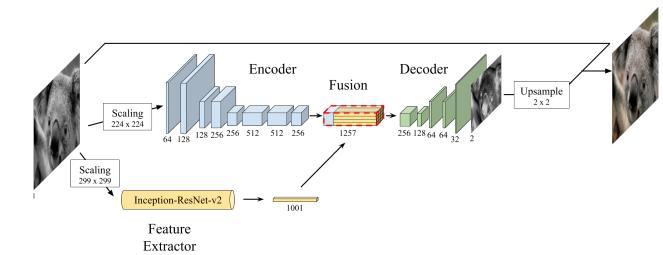
Thisinvolvestransferringthegrayscaleimagethroughthe trainedmodeltoproduceacolorizedoutputimage.Overall,

theVGG16structurewithoutpoolinglayersisanimportant tool for image colorization using deep learning ways. Its capabilitytocapturefine-granulateddetailsandtexturesin theimage,alongwithitsadaptabilityandflexibility,makeit a precious tool for a range of computer vision tasks. The execution of the model in Caffe is straightforward, but it requires a large dataset and significant computational resourcesfortrainingandoptimization.

4. EXPERIMENTAL RESULTS


4.1 Model 1
Emil Wallner’s public dataset from Floydhub was used to traintheneuralnetwork.Imagesofdimension256X256X3 are used in the training data Wallner’s training dataset consistsof200imagesofnaturalfacesandthetestconsists of50imageswithadimensionof256X256X1.Fig5shows theselectedimagesinthetestingdatasets.Aftertrainingand learning, the neural network will find traits that link each grayscale value to corresponding color values. The figure shows the sample images in the test dataset. During the testingaspect,sometestinputsarefedtotheneuralnetwork to check the performance. The testing inputs also pass through the preprocessing, segmentation, and feature extractionsteps.Theinputandoutputimagesareshownin Fig 6. Good quality results can be attained within a reasonabletimewithoutanynaturalhelp.
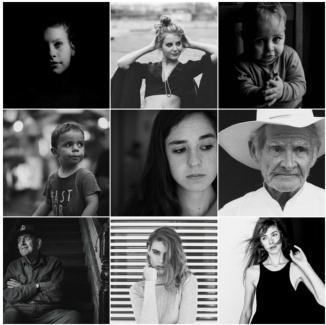
4.2 Model 2
Oncetrained,wefedournetworkwithsomeimages. Theresultsturnedouttoberelativelyreasonableforsome oftheimages,generating-photorealisticpictures.Still,due tothesmallsizeofourtrainingsetournetworkperforms betterwhencertainimagefeaturesappear.Forcase,natural essentials like the ocean or greenery seem to be well honored.Still,specificobjectsaren'talwayswell-colored.Fig 7 illustrates results for some cases where our network producesalternative-coloredestimates.Inthefirstrow,our approachisableofhonoringthegreenvegetation.Still,the butterflywasn'tcolored.Likewise,intheillustrationinthe alternate row, we observe that the network changes the coloroftherowers’clothesfromgreen-yellowtored-blue.
The last row shows a geography illustration where our modelhandedaphoto-realisticimage.
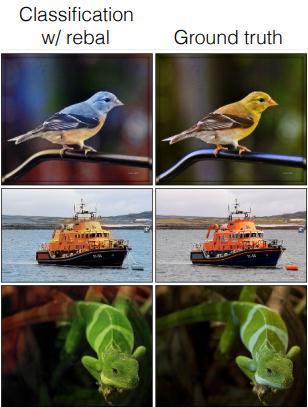

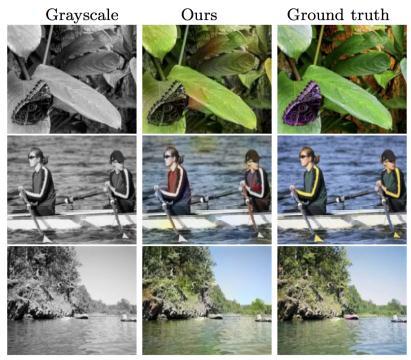
5. CONCLUSION
Imagecolorizationisachallengingcomputervision taskthathasreceivedconsiderableattentioninrecentyears. Manydeeplearningmodelshavebeenproposedtoaddress thisproblem,eachwithitsstrengthsandweaknesses.Inthis comparison, we will examine three popular models for imagecolorization:BaselineCNN,Inception-ResNetv2,and theCaffemodel.
BaselineCNNisasimpleconvolutionalneuralnetworkthat iscommonlyusedasastartingpointforimagecolorization. Ittypicallyconsistsofseveralconvolutionallayersfollowed byoneormorefullyconnectedlayers.Thearchitecturecan beadjustedbasedonthespecificrequirementsofthetask, suchasthesizeoftheinputimagesandthenumberofcolor channels.
Wetrainthisnetworkonthe1.3Mimagesfromthe ImageNettrainingset[9],validateonthefirst10kimagesin theImageNetvalidationset,andtestonseparate10kimages inthevalidationset.
In this method [10], with classification loss and class rebalancing thenetwork wastrainedfromscratchwithkmeans initialization, using the ADAM solver for approximately 450k iterations. The input, output, and ground-truthimagescanbeseeninFig8.
Inception-ResNet v2 is a more advanced model that combines the Inception architecture with residual connections. The Inception architecture is known for its abilitytoextractfeaturesatmultiplescales,whileresidual connections help to prevent vanishing gradients during training.Thismodelisverydeepandcomplex,withover100 layers,whichallowsittocapturehighlydetailedfeaturesin theimage.
The Caffe model is based on the VGG16 architecture but without any pooling layers. It is a regression model that takesagrayscaleimageasinputandproducesacolorized output image as the prediction. The model is trained on a large dataset of color images and their corresponding grayscaleversions,learningtoassociatedifferentgrayscale valueswithspecificcolorvalues.Thismodeltendstohavea MSE of 0.0039,PSNR of 24.761db,AIT of 0.58s.This values obtainedaremorethanthetwomodelsexceptAIT.Butwe can ’t relied on this.Because our objective is to produce plausiblecolorswhichlookslikearealimage.
Tocomparethesemodels,wecanconsiderseveralfactors, includingtheiraccuracy,speed,andmemoryusage.Interms ofaccuracy,allthreemodelshaveshownimpressiveresults inimagecolorizationtasks,witheachmodelabletoproduce realistic and vibrant colorizations. However, InceptionResNetv2tendstooutperformtheothermodelsintermsof accuracy, thanks to its ability to capture highly detailed featuresintheimage.
Intermsofspeed,BaselineCNNisthefastestmodelofthe three due to its simpler architecture. However, InceptionResNet v2 and the Caffe model are also able to produce colorizationsrelativelyquickly,andtheirspeedisgenerally consideredacceptableformostapplications.
Intermsofmemoryusage,theCaffemodeltendstorequire the most memory due to its large dataset and complex architecture.However,thisisnotalwaysasignificantissue,

as modern hardware can often handle the memory requirementsofdeeplearningmodels.
Overall, it is difficult to declare one of these models as definitivelybetterthantheothers,aseachhasitsstrengths andweaknesses.BaselineCNNisagoodstartingpointfor imagecolorizationtasksandcanproducegoodresultswith lesscomputationalcomplexity.Inception-ResNetv2offers high accuracy and detail, making it a good choice for applicationsthatrequirethemostprecisecolorizations.The Caffe model is a powerful tool for image colorization, particularlyincaseswheredetailedcolordistributionsare critical.
In addition to these models, many other deep-learning models have been proposed for image colorization. For example,GAN-basedmodelssuchasPix2PixandCycleGAN haveshownpromisingresults,whileothermodelssuchasUNet and MobileNet have also been used for image colorization.Theperformanceofdifferentmodelsofpix2pix is shown in terms of MSE, PSNR, and average inference time[11]intable1.Thechoiceofthebestmodelultimately dependsonthespecificrequirementsofthetask,suchasthe available resources, the desired accuracy, and the applicationcontext.
In conclusion, image colorization is a complex task that requires a deep understanding of the image data and the bestapproachtoextractthemostrelevantfeatures.Baseline CNN, Inception-ResNet v2, and the Caffe model are three popular models for image colorization that have their strengths and weaknesses. Other models like GAN-based models,U-Net,andMobileNethavealsoshownpromisein this area. The choice of the best model depends on the specificneedsofthetaskathand.
Table 1: PerformanceofdifferentModelsintermsofMSE, PSNR,and Averageinferencetime(AIT).
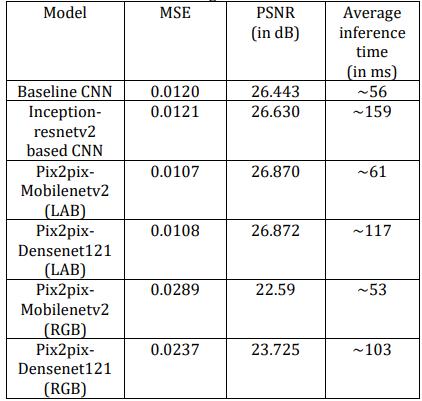
REFERENCES
[1] V.Bochko,P.V¨alisuc,T.Alho,S.Sutlnen,J.Parkkinen, and J. Alander, “Medical image colorization using learning”,pp.70–74,Jan.2010.
[2] R.C. Gonzalez, R.E. Woods, “Digital Image Processing” second ed., Addison–Wesley Publishing, Reading, MA, 1987.
[3] A.Levin,D.Lischinski,andY.Weiss,“Colorizationusing optimization,” ACM Transactions on Graphics, vol. 23, no.3,pp.689–694,2004
[4] H.Noda,M.Niimi,andJ.Korekuni,“Simpleandefficient colorization in YCbCr color space,” in International ConferenceonPatternRecognition,2006,pp.685–688.
[5] D. Nie, Q. Ma, L. Ma, and S. Xiao, “Optimization-based grayscale image colorization,” Pattern Recognition Letters,vol.28,pp.1445–1451,2007.
[6] X.Ding,Y.Xu,L.Deng,andX.Yang“ColorizationUsing Quaternion Algebra with Automatic Scribble Generation”Springer-VerlagBerlinHeidelberg2012.
[7] Bo Li, Fuchen Zhao, Zhuo Su, Xiangguo Liang, Yu-Kun Lai, Paul L. Rosin “Example-based Image Colorization using Locality Consistent Sparse Representation” Journal of latex class files, Vol. 13, NO. 9, September 2014
[8] Iizuka,S.,Simo-Serra,E.,Ishikawa,H.:Lettherebecolor! : joint end-to-end learning of global and local image priors for automatic image colorization with simultaneous classification. ACM Transactions on Graphics(TOG)35(4)(2016)110
[9] Russakovsky,O.,Deng,J.,Su,H.,Krause,J.,Satheesh,S., Ma,S.,Huang,Z.,Karpathy,A.,Khosla,A.,Bernstein,M., etal.:Imagenetlargescalevisualrecognitionchallenge. InternationalJournalofComputerVision115(3)(2015) 211–252
[10] R. Zhang, P. Isola, and A. A. Efros, “Colorful image colorization,”inECCV,2016.
[11] AbhishekKumbhar,SagarGowda,RuchirAttri,Anjaneya Ketkar,Prof.AnkitKhivasara,"ColorizationofBlackand White Images Using Deep Learning" in IRJET vol 08., Issue:Oct2021.
[12] S. Titus and J. R. N.M., "Fast Colorization of Grayscale Images by Convolutional Neural Network," 2018 International Conference on Circuits and Systems in Digital Enterprise Technology (ICCSDET), Kottayam, India, 2018, pp. 1-5, doi: 10.1109/ICCSDET.2018.8821180.

